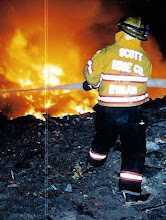At the tender age of three, most
youngsters can identify a firefighter.
Even with the myriad colors, shapes, and styles today, the helmet, going
back almost 200 years is synonymous with the job. The first fire helmets, hats really, would
hardly be identified as such today. They
resembled top hats, Lincolnesque in style, but with a band or painting to
identify the company the individual belonged to more so than to provide
protection.
Jacob or Jacobus Turck is
generally credited with this design from around 1740. This lasted around 100 years until Henry T.
Gratacap designed a new helmet constructed of hardened leather sections for
protection and a large rear tail to help shed water. Although changes and improvements have been
made, the shape of this original design from around 1836 (dates differ) is the
one even children could recognize today.
Gratacap’s operation continued to
grow and in 1869, he sold it to two brothers; Jasper and Henry Cairns, who
possessed a last name which is arguably the most well known in the helmet
business today. Cairns brothers
continued to evolve the designs and materials, but the leather helmet remained
a core component of their business. In
1937, Cairns introduced an aluminum helmet.
A generation later, in 1962, their vacuum formed polycarbonate helmet
line began; and in the “modern” era, Philadelphians, Phoenix, and Metro helmets
were among the new style that some saw as a radical change from the classic
shape. But it was radical only at first
glance as even these helmets retained the short front brim and longer rear
tail. Helmet types and styles have
developed fans and detectors over the years.
Leather helmet devotees sometimes disparage the plastic models as
“Tupperware.”
Aluminum Helmet
Cairns Metro Helmet
Although safety standards have
dramatically changed the interior, the exterior of a leather helmet
manufactured today, as well as the classically shaped plastic versions, would
no doubt be recognizable by Henry Gratacap or the original Cairns
brothers. In a world where change seems
to be the only constant, that the basic design of the fire helmet could remain
intact for 177 years is nothing short of amazing.









No comments:
Post a Comment